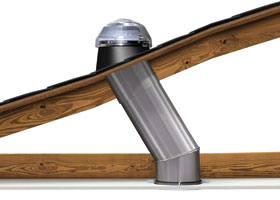Sun In
 We’d all love to let in a little more sunlight, particularly as the days grow shorter, but that pesky roof keeps getting in the way. While bulky, traditional skylights have been used for years to open up roof space and illuminate interiors, light tubes, also known as solar tubes, are a slimmer, less expensive and more energy efficient way to channel natural light inside.Both skylights (which are flush to the ceiling and don’t open) and roof windows (which are set back from walls and open) let in lots of hot direct light that can fade upholstery over time and allow heating or cooling to escape, raising energy bills and wasting electricity. And condensation on skylights and roof windows can drip down and ruin paint.
We’d all love to let in a little more sunlight, particularly as the days grow shorter, but that pesky roof keeps getting in the way. While bulky, traditional skylights have been used for years to open up roof space and illuminate interiors, light tubes, also known as solar tubes, are a slimmer, less expensive and more energy efficient way to channel natural light inside.Both skylights (which are flush to the ceiling and don’t open) and roof windows (which are set back from walls and open) let in lots of hot direct light that can fade upholstery over time and allow heating or cooling to escape, raising energy bills and wasting electricity. And condensation on skylights and roof windows can drip down and ruin paint.
Light tubes—shafts that reflect light down into a room from the roof— have an edge over traditional skylights for a handful of reasons. For one, “they’re much cheaper to install,” says Kris Beyer of Skylight Guys in Phoenix, Arizona. Complete installation of a traditional skylight will set you back about $1,500 to $1,800; a solar tube only costs about $400 with installation. As a bonus, some Energy Star light tube models can earn a federal income tax credit worth up to 10% of the purchase cost.
Easy Access

Solar tubes are also less of an ordeal to install. With traditional skylights, the process of drywalling, painting and installing can take days. Installing a solar tube takes about two hours.Tube sizes vary depending on the amount of light you want to let in, from 10- inch to more than 20-inch diameters. Most light tubes are used to illuminate bathrooms, though they can be added to nearly any room. Unlike a traditional skylight, light tubes can curve around attic rafters or be directed down between walls to reach lower levels. During a full moon, light tubes can even pick up silvery moonlight for subtle night lighting.
Solar tubes run 18′ to 20′ at their longest, according to Beyer, but he adds: “You won’t get as much light out of it at that length…15′ is where you start seeing light loss.”
Most solar tubes have a clear dome—about the diameter of a basketball or smaller—that captures full-spectrum sunlight. Light then travels down shiny metal tubing lined with a highly reflective liquid silver coating that’s chemically bonded to the inside of the tube. “It’s 98% to 99% reflective,” Beyer says. “It acts as a mirror. Then the light disperses evenly when it hits the diffuser.”
Looking much like a recessed light, sunlight coming through the ceiling hits a frosted glass diffuser and illuminates the living space with bright, indirect light; UV filters save interior fabrics from fading. And most light tubes are designed to be maintenance-free.
You’ve Got Options
Solar tubes come in a range of models, including some with special features like a natural lighting controller that acts as a dimmer switch to tone down light intensity. Newer hybrid light tube models let in natural light by day and provide compact fluorescent light when the sun goes down. Solatubehas a 90-degree adapter so the tube can travel horizontally to bypass obstacles. The company also makes a turret that raises the height of the Solatube dome on a roof to avoid snow or other shade-producers.
Even more futuristic, some new light tubes come equipped with solar florescent capability that can capture UV rays, convert them into red and green light, and illuminate interiors with fluorescent light on overcast days. Other light tubes are packed with fiber optics in the shaft instead of reflective material. After a series of lenses absorb light from the roof, light is then channeled down through fiber optic lines to the room.
Fiber optic tubes and solar-storing fluorescent tubes are still too expensive for the average homeowner and aren’t yet ready for the green building market. But until they arrive, there are plenty of solar tube options for the rest of us.

